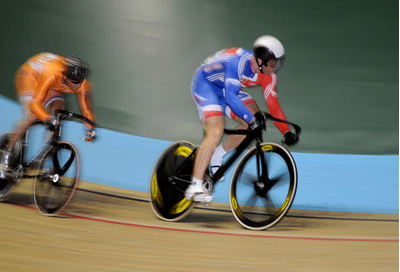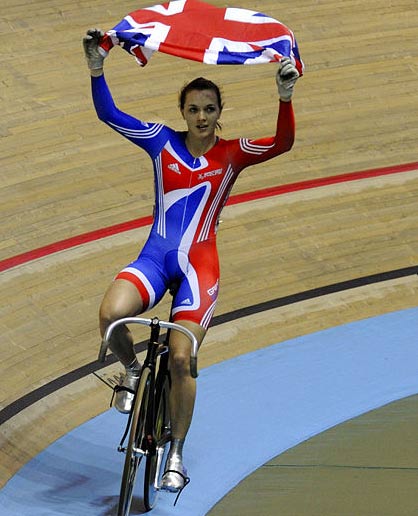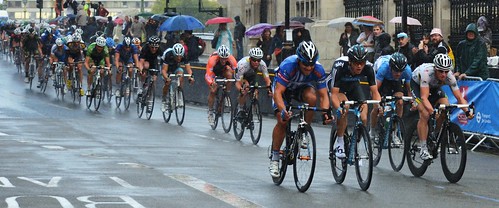
Sprinters are the superstars of cycling. I’ll never be a sprinter myself, but I love watching them in action.
The greatest cyclists who win grand tours are quite often perceived as dull riders (perhaps unfairly), e.g. Miguel Indurain who dominated in the time trials and then defended in the mountains; Armstrong who ’tediously’ overpowered his rivals. Yet, sprinters can never be seen as dull. The sheer excitement of a bunch sprint is hard to match in other sports. You can watch an entire 6 hour stage in the tour, where pretty much nothing happens, for it all to explode in the last 1 minute as the sprinters come to the fore.
Body Type of Sprinters

Sprinters tend to be short and powerfully built. They Will have a high ratio of ‘fast twitch’ muscles. These are muscles which perform well under anaerobic exercise (lack of oxygen). Someone like Chris Hoy is the archetypal track sprinter – powerfully built, muscles bulging! To some extent this also applies to women, though a great sprinter isn’t necessarily the stereotypical butch Eastern European sprinter. Victoria Pendleton is quite slim for a sprinter. But, she will have a high % of fast twitch muscles which enable her to sprint at high speeds.

Sprinters excel in anaerobic bursts. Here it is muscle strength as much as aerobic capacity.
Best Sprinters in Cycling
Sprinters tend to be the superstars of the sport. There is something about the nature of sprinting that brings out the show boatmen. Some of the most charismatic figures in the sport were sprinters. For example, the great Mario Cippolini. His ability as a sprinter was matched by his disregard for authority; he used to get fined by the judges as often as he would win races and stages. (for example, the time he turned up in a skin suit which was designed to look like the insides of his body) Cippolini thought nothing of winning 4 stages on the tour de France and then retiring to a poolside villa sipping a nice cool drink. To purists who see cycling as all about suffering, sprinters who have such a laid back attitude can come in for criticism. Though the idea that sprinters have an easy time is not the reality. If you can win a stage in any grand tour, you will have put an awful lot of work in.
Sprinting and Climbing
Sprinters rarely make good climbers because they tend to have a higher weight to power ratio. Yet, there are exceptions, for example, Thor Hushovd, Bogan Hasen and Laurent Jalabert are good sprinters and also quite respectable climbers. Jalabert was actually a winner of green jersey, but after bad sprint crash reinvented himself as a climber and went onto win the King of the Mountains. Yet, a pure sprinter will never be challenging for the King of the Mountains. Nor, will they be in with a chance of winning a grand tour.
A sprinter like Mark Cavendish is what you may call a pure sprinter. He is simply the fastest person on a bike at the moment. interestingly when Mark Cavendish was given a test by British Cycling the usual scientific tests (like VO2 max) were disappointing.
Usually with his aerobic test results he would not have been accepted. It took an exception for Cavendish to be accepted into the British programme because he had great potential to win races.
…And when he first applied for a place on the Olympic academy he nearly didn’t make the cut because the numbers he posted in the various lab tests did not meet the required level. It took John Herety, Rod Ellingworth and Simon Lillistone to convince Peter Keen that an exception should be made for Cavendish because they felt he had a winner’s instinct… (cycling weekly article on Cavendish)
However, whilst Cavendish is a pure sprinter, it would be a mistake to ignore his other capacities. To win Milan San Remo (288Km and several hills) requires a supreme effort. You can’t just rely on a sprint, you need very good endurance and aerobic capacity to get to the finish line.
Setting it Up for A Sprinter
A good sprinter also needs a good team to control the race and make sure breakaways don’t escape the peleton.
One of the most commonly asked questions about the tour, is why do the breakaways always seem to get caught with about 10km to go? Usually it is because the sprinters teams are working to bring back the breakaway with the minimum of effort. They will have a rough idea how quickly they can peg back a breakaway. The idea time is to bring back a breakaway at the last moment. They don’t want to bring back a breakaway straight away – this will require a greater effort and if they bring it back too early, it may encourage a second break to go. If it looks like they are going to peg back the breakaway with 30km, they may actually ease off and stop chasing. This gives them a break at the front and makes other teams come forward.
They will try and time it to bring back breakaways in last few Kms.
Staying With the Bunch
In a flat stage, it is usually no problem for a sprinter to stay in bunch, but in hilly one day classics it is a real challenge not to get dropped on the many climbs. A sprinter like Mark Cavendish may find himself yo-yoing up and down the peleton to stay in contention. Helped by team mates Cavendish will try to position himself near the front of the bunch on the approach to a climb. During the climb, he will allow himself to slowly drop back through the bunch. This enables him to take a little longer on the climb than other riders. Then on the descent and flat, teammates can help him back to the front of a climb, to again play the game of dropping back before going to the front. This kind of tactic helped Cavendish stay in bunch for Milan San Remo.
It is a risky business, as if you are at the rear of the bunch, you could miss a split. It also puts pressure to weave your way through the bunch at a time when everyone wants to be on the front. However, it may be the only way for a pure sprinter like Cavendish to say in contention during short sharp climbs. This tactic is ideal for a race like Milan San Remo, where are few short steep climbs near the finish threaten to finish off the sprinters.
Sprint Trains
 (Flickr, R.King)
(Flickr, R.King)
In the past few decades we have seen the evolution of ‘sprint trains’. This is when the whole 9 man team ride on the front with the idea of delivering their ‘sprinter’ to the front of the race in the last 200 metres. The idea of a sprint train is to
- keep pace high – prevent any last minute breakaways
- Protect their rider.
- Keep sprinter sheltered from wind until last possible 200 metres.
- Each rider will have a specific target – take peleton to 2km, 1km, 500metres.
- The lead-out man is the final member of the team who will be last to peal off before giving sprinter chance to come through.
When it works well and you have a great sprinter, it is hard to beat. But, it can be difficult to get timing right. Other riders may also try to break into a ‘train’ or sneak in the back of a train. A great sprinter like Cavendish will be able to win even without a train by getting into position.
It is an irony of cycling that the guy who wins the race, may not be in the front of the peleton, until the last possible moment.
Tactical Nous

A great sprinter also needs great bravery, nerve and tactics. It is one thing to be the fastest sprinter, it is another to pick the right wheel and go at the right time. It is also important to sprint in a straight line. Who can forget Djamolodine Abdujaparov (btw: google is a wonderful thing for checking spelling) powering his way into the crash barriers at 40mph on the Champs-Élysées?
When To Come to the Front
A key issue for a sprinter is when to come to the front. If you come too early, you will be tired by being out in front. If you leave it too late, you can get boxed in. The ideal point is coming into last Km in top 10. Then at 200metres opening up your sprint.
Top 10 Sprinters of All Time
- Mario Cippolini – 57 stages in Grand tours (42 in the Giro)
- Mark Cavendish – 20 stages in tour de France and counting
- Freddy Maertens – 16 stages in tour de France, 2 world championships,
- Sean Kelly – 21 grand tour stages
- Erik Zabel – 6 times green jersey winner Tour de France (over 200 professional wins)
- Rik Van Looy – classics specialist of his era.
- Oscar Freire – 3 world championships, 11 grand tours
- Alessandro Petacchi – 51 Grand Tour stages
- Tom Boonen – great classics specialist
- Robbie McEwan
Image top (Cavendish) scarlatti2004
Image Pendleton, Chris Hoy – Tim Redgrove (c)
Related


I worked at the commonwealth games in Manchester in the velodrome and it basically looked like these guys were just cycling as fast as they could, never realised this much effort and tactical stuff went into it.
Good article.
i’m loving ‘and counting’ for cav that sounds about right